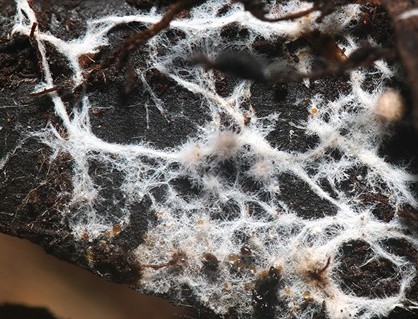Meat substitutes are gaining acceptance in Western diets these days. We have hamburgers and sausages made from plant substitutes. And now it appears we have a product that looks and tastes like bacon. The pigs are pleased.
Eben Bayer is the co-founder and CEO of MyForest Foods. A former pig farmer who considers what we use these sentient animals for as “horrible,” he heads up a 7,500 square metre (75,000 square foot) vertical farm located in Green Island, New York just north of Albany. Here the company is growing mycelium and harvesting it to make a bacon substitute. The current capacity can produce up to 1.3 million kilograms (3 million pounds) annually.
What is Mycelium?

The picture above is a sample of mycelium. Although we recognize mushrooms as fungi, that’s not even half the story. The living fungus largely lies beneath the soil surface in the form of mycelium. The mushroom is the equivalent of a fruit or flower. The living thing producing it is that white-thready stuff seen in decaying leaves, wood, and soils. It pervades the forest floor and those threads act as an underground network described by botanists as the plant kingdom’s answer to the Internet, a “wood-wide web.”
Mycelia (the plural), are microscopic hollow tubes that act as conduits for the fungus but also for neighbouring plants offering a medium for bioactive chemical compound exchanges. It is not an exaggeration to consider a mycelial network found beneath forests and fields to be as significant as what grows atop serving as both a communication and defence network.
So how is MyForest Foods turning mycelium into a bacon substitute? Two vertical pressurized silos are where the company grows its mycelium. The environment within the silos emulates a dark and dewy early morning forest.
Eat Mycelium! Why Would I?
If you are a mushroom lover like me, you already are eating a form of it. What MyForest is doing is just cutting out the fruiting stage and using the bulk of the fungi as food.
Creating a bacon substitute could become a real bonanza. Consider that we eat bacon with eggs for breakfast. We put it in bacon-lettuce-and-tomato sandwiches for lunch. And we top our burger dinners with it regularly. Average consumption per person in the U.S. amounts to 51 slices per year.
The Production Process
The growth medium is wood chips mixed with water to make a slurry that is then heated under pressure. The feedstock cells come from oyster mushrooms. The mycelium is kept dark and wet within the vertical space. It is harvested in slabs which are then sliced. Salt, sugar, coconut oil, beet juice, and liquid smoke complete the look and taste to create a perfect bacon substitute.
MyForest admits it is not trying to create a health food to replace pork-based bacon, although the product is far healthier than the real thing. But the company does see a long-term benefit if the product catches on. That’s because it could reduce the number of pigs that get slaughtered annually, and eliminate pig-farming pollutants and the carbon emissions that the industry creates.
Other Uses for Mycelium
Bayer has a vision of mycelium’s future. He is not alone as other companies are exploring harvesting the fungus for a variety of uses including:
- Meat substitutes – mycelium that mimics chicken and steak.
- Building materials – created from mycelium mixed with agricultural waste.
- Clothing – mycelium-based synthetic suede and other materials.
- Packaging – mycelium packing materials and containers including foam and plastic substitutes that degrade after end-of-use.
- Medicine – mycelium-derived antivirals, antibacterials, anti-aging, anti-inflammatory, hypocholesterolemic, and antioxidant compounds.
After learning about mycelium you’ll never look at a mushroom the same way you did before reading this posting.










[…] MyForest Foods makes mycelium bacon. […]